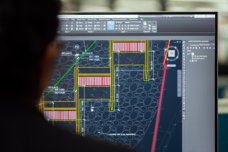The development of artificial intelligence is contributing to the field of geo-information science, with algorithms being developed to automatically scan and interpret this visual information. With the data from satellites and the insights from algorithms, we are able to access real-time observation of large-scale changes occurring on our planet. This spatial information has many possible uses, but one of them is to combine it with financial dynamics and integrate it into financial decision-making processes. This is the concept of “Spatial Finance”.
Why is Spatial Finance important?
The increasing frequency of droughts, wildfires and floods disrupts production and damages infrastructure, resulting in financial losses that are substantial but often hard to quantify. Spatial data collected during these disasters can play a vital role in accurately assessing the financial damages. This application of spatial finance has the potential to mitigate the economic impact of disasters and bolster community resilience globally. For instance, it can help address food scarcity and price spikes by remotely assessing agricultural lands in specific regions, thereby informing public policies to combat hunger and social unrest in vulnerable areas.
Spatial finance is also instrumental in promoting transparency within the financial systems of many companies and organizations. Due to their size and production scale, numerous multinational corporations lack a comprehensive understanding of the origins of their assets and raw materials, making it challenging to trace the sources of their products. Some of these sources may have adverse societal impacts, such as unsustainability or poor working conditions for laborers. Spatial finance offers a solution by leveraging spatial data to trace product origins and enhance transparency in the production process.
What is the CBA?
To enhance the overall effectiveness and sustainability of financial decisions in spatial contexts, financial resources are allocated in a way that maximizes returns and minimizes spatially-linked risks. This is where the cost-benefit analysis (CBA) comes in.
CBA is a tool that enables decision-makers to assess the economic viability of spatially-oriented investments, risk management strategies, and policy interventions. By quantifying both the costs and benefits associated with spatial finance initiatives, such as infrastructure projects, disaster mitigation measures, or real estate developments, it allows for informed choices that consider spatial factors like geographic location, proximity to resources, and exposure to risks.
What do we do at ITC?
The ITC Faculty develops projects related to spatial finance with global impact, like GIACIS. The GIACIS project has developed an insurance instrument for Ethiopian farmers. It reduces the impact of drought-related shocks to the income of smallholder farmers, especially when they make extra investments using credit or their own capital. The ITC Faculty has developed the method, algorithms and tools to interpret satellite imagery to monitor the status of green vegetation. This information is used to calculate the severity of drought and to determine the indemnity payments. The project aims for farmers to be automatically insured against drought.
The GIACIS is a public-private partnership between the ITC Faculty, Kifiya Financial Technology, the Agricultural Transformation Agency (ATA) and the National Meteorology Agency (NMA) of Ethiopia. This project is funded by Geodata for Agriculture and Water (G4AW).






